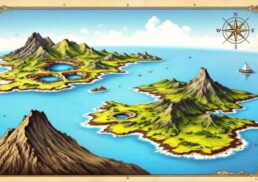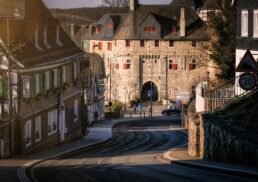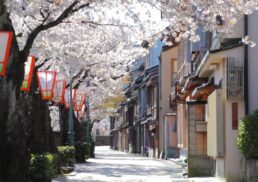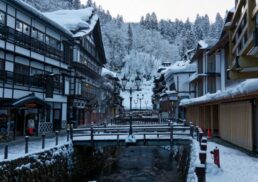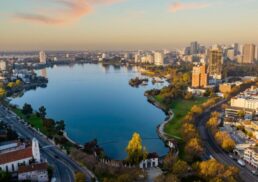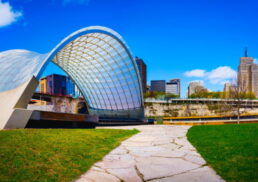Dresden is a city of stunning architecture and rich history, earning it the title ‘Jewel Box’ of Eastern Germany. This article explores the city’s top attractions including famous landmarks, extensive art collections, and vibrant modern life. Join us as we uncover why Dresden is a must-visit destination.
Table of Contents
Key Takeaways
Dresden, known as the ‘Jewel Box’ of Eastern Germany, is celebrated for its rich cultural heritage, including baroque and rococo architecture, significant art treasures, and prestigious museums such as the Dresden State Art Collections.
The city’s historical landmarks like the Royal Palace, Zwinger Palace, and Semper Opera House, along with its iconic attractions such as Brühl’s Terrace and Dresden Frauenkirche, showcase Dresden’s architectural and cultural grandeur.
Modern Dresden seamlessly integrates its historical charm with contemporary advancements, boasting a robust economy driven by high-tech industries, a comprehensive public transportation system, and vibrant cultural scenes including festivals, performing arts, and nightlife.
Dresden’s Cultural Significance
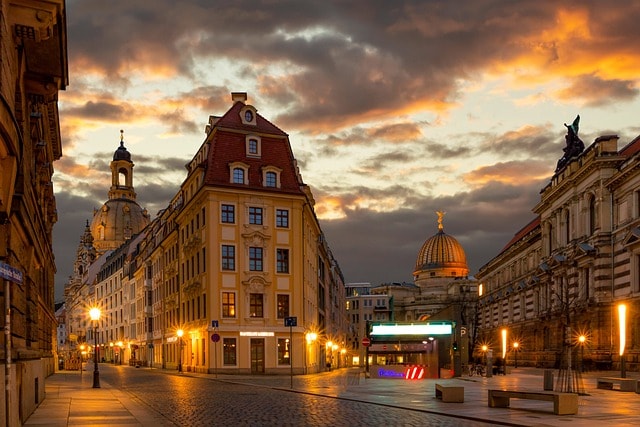
Dresden, often celebrated as the ‘Jewel Box’ of Eastern Germany, is a treasure trove of cultural landmarks and historical marvels. The city’s cultural significance is highlighted by its vast array of art treasures, historic buildings, and prestigious museums that attract visitors from around the globe. Dresden lies in the heart of Saxony, a region known for its rich cultural heritage and historical importance.
The old town of Dresden is adorned with baroque and rococo architecture, earning it the nickname ‘Jewel Box’. The city’s renowned Dresden State Art Collections are among the most significant and oldest in Europe, comprising fifteen museums that display a remarkable range of artworks. We will explore the rich tapestry of Dresden’s cultural heritage, spanning from precious art collections to historic edifices and prestigious museums.
Art Treasures
The origins of the Dresden State Art Collections trace back to the sixteenth-century Kunstkammer of the Saxon electors, further enriched by acquisitions from the Saxon electors and Polish kings. These collections, which are spread across twelve museums, boast a comprehensive range of artworks including Renaissance and Baroque masterpieces. The Dresden State Art Collections, one of Germany’s most respected art centers, present a remarkable journey through art history, from antiquity to contemporary works.
Among the notable galleries is the New Masters Gallery, featuring 19th and 20th-century paintings by German Romantic artists like Caspar David Friedrich and Ludwig Richter, alongside works by French and German Impressionists such as Claude Monet and Max Liebermann. The Albertinum, reopened in 2010, houses art from Romanticism to contemporary works, illustrating Dresden’s commitment to preserving and showcasing its rich artistic heritage. In August 2024, to mark the 250th birthday of Caspar David Friedrich, the Staatliche Kunstsammlungen Dresden will feature special exhibitions of his work.
Historic Buildings
The rich architectural legacy of Dresden is embodied in its historic buildings. The Royal Palace, built in the 15th century and also known as the Residenzschloss, is one of the city’s most significant historic buildings. It has undergone extensive reconstruction and now hosts multiple museums, showcasing a blend of historic architecture and cultural exhibitions.
The Zwinger Palace, located in Dresden’s Theaterplatz, is another architectural marvel. Originally a site for lavish royal celebrations hosted by the Wettin dynasty, the Zwinger today stands as a symbol of baroque opulence and houses important museums. These historic buildings, along with other notable structures in the old town, reflect the city’s grandeur and historical depth.
Museums
Housed within some of the city’s most iconic buildings, Dresden’s museums offer insights into its rich cultural and historical fabric. Some of the key museums in Dresden include:
The Green Vault, renowned for its treasure chamber showcasing valuable artworks and historic artifacts
The Sculpture Collection
The Cabinet of Prints and Drawings
These museums, established by August the Strong, provide a unique and fascinating experience for visitors.
The Dresden State Art Collections, housed in the Royal Palace, Zwinger, and Semper Building, provide an immersive experience into the art and history of Dresden. The collection includes:
The Old Masters Picture Gallery, featuring works by Raphael, Rembrandt, and Vermeer
The Green Vault, showcasing a stunning collection of jewelry and precious objects
The Porcelain Collection, displaying exquisite porcelain pieces from Meissen and other manufacturers
The Sculpture Collection, featuring an extensive range of sculptures from antiquity to the present
These museums not only preserve the city’s cultural heritage but also serve as major attractions for visitors.
Top Attractions in Dresden
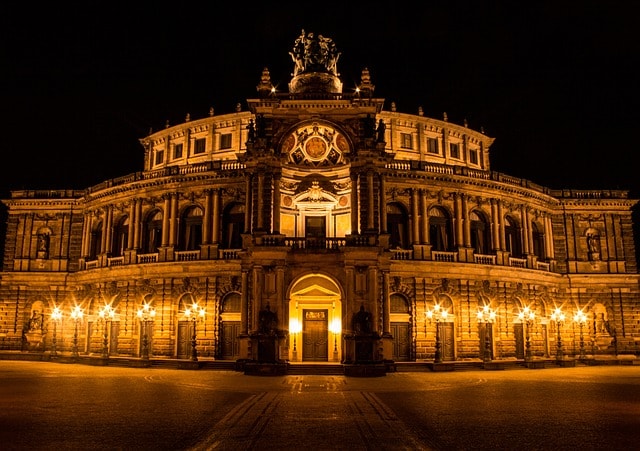
Dresden is adorned with a plethora of attractions, each echoing the city’s rich cultural and historical lineage. The Semper Opera House, Brühl’s Terrace, and the Dresden Frauenkirche are among the city’s most iconic landmarks. Each of these attractions offers a unique glimpse into Dresden’s artistic, architectural, and spiritual legacy.
Recognized as a cultural landmark and architectural wonder, the must-visit sites in Dresden include:
The Semper Opera House
Brühl’s Terrace, known as the ‘Balcony of Europe’ for its breathtaking Elbe River views
The Dresden Frauenkirche, a symbol of reconciliation and peace
These attractions constitute the core of Dresden’s charm and are must-visit sites for anyone exploring the city.
Semper Opera House
The Semper Opera House, one of Dresden’s most famous landmarks, first opened its doors in 1841. It was rebuilt in 1878 after a devastating fire. Designed by architect Gottfried Semper, the opera house is celebrated for its stunning architectural beauty and excellent acoustics. It is home to the Saxon State Orchestra and hosts world-class performances, making it a top cultural venue in the city.
Locally known as the Semperoper, this establishment serves as an emblem of Dresden’s affluent musical history and architectural sophistication. Its location near the Royal Palace and Zwinger Palace adds to its prominence in the city’s cultural landscape. A visit to the Semper Opera House is a journey into the heart of Dresden’s artistic soul.
Brühl’s Terrace
Brühl’s Terrace, often called the ‘Balcony of Europe,’ offers breathtaking views of the Elbe River and the cityscape of Dresden. This historic promenade is a popular spot for both locals and tourists, providing a tranquil setting to enjoy the scenic beauty of the city. The terrace is lined with historic buildings and monuments, adding to its charm and historical significance.
Walking along Brühl’s Terrace, visitors can admire the architectural splendor of nearby landmarks and enjoy the vibrant atmosphere of the Elbe River promenade. The terrace is particularly enchanting in the evening when the city lights reflect on the river, creating a picturesque view that is quintessentially Dresden.
Dresden Frauenkirche
The Dresden Frauenkirche, or Church of Our Lady, is a Baroque Lutheran church that was originally completed in 1743. The church was left in ruins after World War II and stood as a poignant war memorial for 50 years. Following German reunification, reconstruction began, and the church was restored to its former glory, reopening in 2005.
Today, the Frauenkirche stands as a symbol of reconciliation, peace, and the resilience of Dresden. Its magnificent dome dominates the skyline of central Dresden, attracting visitors with its architectural beauty and historical significance. The church’s reconstruction is a testament to the city’s commitment to preserving its cultural and spiritual heritage.
The Historical Journey of Dresden
Dresden’s history is a rich tapestry that spans from its early beginnings as a Slavic village to its current status as a major cultural and political center in Germany. The city has seen periods of great prosperity, devastating destruction, and remarkable reconstruction. Join us on a journey through Dresden’s history, spotlighting pivotal events and landmarks that have forged the city’s unique identity.
Dresden’s narrative includes:
Its early days as the Saxon capital
The devastation of World War II
Its extensive post-war rebuilding
The significant development and urban renewal in the post-reunification era
This makes Dresden, the largest city with its bustling city centre, one of Germany’s most vibrant and dynamic cities.
Early History
The area where Dresden is located has been settled since the Neolithic era by Linear Pottery culture tribes around 7500 BC. Initially a Slavic village, Dresden evolved into the capital of Saxony, reflecting its growing importance and strategic location. The city’s name is derived from the Sorbian word ‘Drježdźany,’ which means ‘people of the forest’.
As Dresden grew, it became a significant cultural and political center, particularly during the mid-18th century, known as its Golden Age. This period saw the construction of many of the city’s notable buildings and the flourishing of its cultural institutions, making it a prominent capital city.
The early history of Dresden set the stage for its future as a major European city.
World War II and Reconstruction
The bombing of Dresden during World War II was one of the most controversial and devastating events in the city’s history. Approximately 25,000 people were killed, and the city center was almost completely destroyed. The Frauenkirche was among the many historic buildings that were left in ruins. An inscription on the Altmarkt square commemorates the site where corpses were burned after the bombing in February 1945.
In the aftermath of the war, Dresden underwent extensive reconstruction efforts. Significant historic buildings, such as the Semper Opera House and Zwinger Palace, were meticulously restored. The reconstruction of the Semperoper was completed in 1985, and the Frauenkirche was finally restored in 2005. These efforts have helped Dresden regain its former glory and continue to honor its rich cultural heritage.
Post-Reunification
Since the German reunification in 1990, Dresden has become a significant center for culture, education, and politics within Germany. This transformation has reinforced its status as a major hub in the country. The city has seen significant urban renewal, particularly around the Neumarkt square, where many buildings have been reconstructed to their original styles.
Today, Dresden is known for its vibrant cultural scene, modern infrastructure, and thriving economy. The city’s development in the post-reunification era reflects its resilience and commitment to preserving its historical legacy while embracing modernity. Dresden stands as a testament to the transformative power of unity and renewal.
Nature and Parks in Dresden

In addition to its wealth of cultural and historical landmarks, Dresden also prides itself on its plethora of verdant spaces and parks. These natural areas provide a serene escape from the urban hustle and bustle, offering residents and visitors alike a chance to relax and enjoy the outdoors. The city’s parks are not just recreational spaces but also hold historical and cultural significance.
Dresden is home to several beautiful parks, including:
Großer Garten: an expansive park with a lake, botanical garden, and a mini railway
Dresden Heath: a tranquil forested area perfect for hiking and biking
Pillnitz Palace Park: a picturesque park surrounding a stunning palace
These parks enhance the quality of life in Dresden and offer a variety of outdoor activities and cultural events.
Großer Garten
Großer Garten, Dresden’s largest park, is a Baroque-style garden that spans 1.8 square kilometers. Designed in the 17th century, it is considered one of the most important Baroque gardens in Europe. Located just a few minutes from Dresden’s city center, Großer Garten offers extensive green spaces, beautifully landscaped gardens, and a miniature railway that runs through the park.
Visitors can enjoy leisurely strolls, picnics, and various recreational activities in this serene environment, making it a true garden city. Großer Garten is a perfect example of how Dresden seamlessly blends its historical heritage with modern recreational amenities.
Dresden Heath
Dresden Heath is a vast urban forest covering approximately 50 square kilometers, making it one of the largest urban forests in Europe. This extensive green space serves as a major recreational area for residents and visitors, offering numerous trails for hiking and cycling. Its diverse flora and fauna create a unique ecosystem that transitions between the North German Plain and the Central Uplands.
Whether you’re looking to explore nature, enjoy a brisk walk, or embark on a cycling adventure, Dresden Heath provides the perfect backdrop. Its natural beauty and tranquility offer a refreshing escape from the city’s urban environment.
Pillnitz Palace Park
Pillnitz Palace Park, located along the Elbe River, is renowned for its picturesque landscapes and botanical gardens. The park features a stunning collection of rare and exotic plants, making it a haven for botany enthusiasts and nature lovers alike. The scenic setting of the park, combined with its historical significance, makes it a must-visit destination in Dresden.
Visitors can explore the beautifully maintained gardens, enjoy the serene river views, and learn about the park’s historical context. Pillnitz Palace Park exemplifies Dresden’s harmonious blend of natural beauty and cultural heritage.
Modern Dresden
Modern Dresden skillfully interweaves its historical allure with contemporary progress. It boasts a well-connected transportation system, a thriving economy driven by high-tech industries, and a strong focus on education and research. These elements contribute to Dresden’s reputation as an attractive place to live, work, and visit.
The city’s infrastructure includes modern transportation networks and an emphasis on environmental sustainability, enhancing the quality of life for its residents. Dresden’s commitment to innovation and development has positioned it as a leading city in Germany.
Transportation
A comprehensive and efficient mix of trams, buses, and widespread cycle paths make up Dresden’s public transportation system. The tram system is the primary mode of transportation within the city center, providing easy access to major attractions and business areas. The city’s main railway station, Dresden Hauptbahnhof, connects Dresden to national and international destinations.
For those arriving by air, there are several transportation options available in Dresden:
S-Bahn line S2 offers a direct connection from Dresden Airport to the Hauptbahnhof
Bus lines and tram services complement each other, ensuring seamless travel within the city
The Deutschlandticket and Dresden Regio Card provide convenient options for tourists to explore the city and its surroundings.
Economy
Buoyed by considerable investments in microelectronics and information technology, Dresden boasts one of Germany’s fastest-growing economies. The city is a key player in these high-tech sectors, alongside emerging industries such as nanotechnology, biotechnology, and renewable energy. This economic dynamism is complemented by a vibrant tourism sector, attracting visitors from around the world.
The city’s strategic investment in innovation and technology has fostered a robust economic environment. Dresden’s blend of historical charm and cutting-edge industries makes it a unique and thriving economic hub.
Education and Research
Dresden is home to numerous universities and research institutions that significantly contribute to its intellectual capital. The city boasts a high concentration of basic and applied research facilities, fostering innovation and academic excellence. These institutions play a crucial role in driving Dresden’s development and maintaining its status as a center of knowledge and research.
The presence of these educational and research institutions not only enhances the city’s academic landscape but also attracts students, scholars, and researchers from around the globe. Dresden’s commitment to education and research underscores its forward-thinking approach and dedication to continuous growth.
Dresden’s Vibrant Culture and Entertainment
Equally vibrant as its historical architecture is Dresden’s thriving cultural scene. The city offers a rich array of performing arts, festivals, and a lively nightlife, making it a dynamic destination for culture enthusiasts. Dresden’s blend of contemporary life with historical charm creates a unique and engaging atmosphere.
The city’s renowned musical culture, including the Saxon State Orchestra and the Dresden Philharmonic Orchestra, adds to its cultural allure. Major events like the Dresden Music Festival attract international artists and audiences, further enhancing Dresden’s reputation as a cultural hub.
Performing Arts
Dresden’s performing arts scene is diverse and vibrant, featuring:
Theaters
Choirs
Cabarets
The unique Dresden State Operetta House
The Staatsschauspiel Dresden is one of the city’s most prominent theaters, offering a wide range of dramatic performances. The Comödie Dresden theater presents a variety of shows, including international guest performances and experimental productions.
The Kreuzchor boys’ choir, one of the oldest and most famous boys’ choirs in the world, regularly performs concerts and services at the Kreuzkirche. Dresden’s State Operetta House, dedicated entirely to operettas, offers a range of musical comedies and fast-paced shows, making it a unique cultural venue in Germany.
Festivals and Events
Throughout the year, Dresden stages numerous festivals and events, each celebrating diverse cultural facets and attracting global visitors. The International Dixieland Festival, held annually in Dresden, is the oldest festival of its kind in Europe and transforms the city into the ‘Dixieland Capital’ every May.
The Dresden Music Festival attracts over 30,000 classical music fans annually, featuring top-class artists and exceptional programs. These festivals and events highlight Dresden’s vibrant cultural scene and its ability to bring together people from different backgrounds to celebrate music, art, and tradition.
Nightlife
The Neustadt district is renowned for its lively bars, clubs, and alternative nightlife scene. This area offers a unique and eclectic mix of venues, making it a popular spot for both locals and tourists. The Kunsthofpassage, with its art-filled courtyards and diverse bars, provides a distinctive nightlife experience.
Whether you’re looking for a quiet evening with friends or a vibrant night out, Neustadt has something to offer. The district’s unique blend of culture, art, and entertainment makes it a must-visit part of Dresden’s nightlife.
Day Trips from Dresden
Dresden’s strategic location serves as a great starting point for venturing into the surrounding regions. Popular day trips include Saxon Switzerland, Meissen, and Moritzburg Castle, each offering unique attractions and experiences. These destinations are easily accessible from Dresden and provide a perfect getaway from the city’s hustle and bustle.
Saxon Switzerland is known for its stunning landscapes and hiking trails, while Meissen is famous for its historic porcelain manufacturing and picturesque old town. Moritzburg Castle, with its beautiful Baroque architecture and scenic lake setting, offers a glimpse into the region’s royal history.
Saxon Switzerland
Situated a few miles from Dresden, Saxon Switzerland showcases a diverse array of landscapes, encompassing table mountains, cliff tops, and rock pinnacles. The Bastei Bridge offers stunning views over the Elbe Sandstone Mountains and is a popular spot for hikers and nature enthusiasts. The park is home to rare animals and plant species, adding to its natural allure.
A day trip to Saxon Switzerland offers:
Extensive hiking trails
Rock climbing opportunities
A unique micro-climate
Dramatic rock formations
It is a haven for outdoor adventurers and one of Germany’s most remarkable natural landscapes.
Meissen
Meissen, located along the Elbe River, is renowned for its historic porcelain manufacturing, which began in 1710 at Albrechtsburg Castle. The picturesque old town and charming streets make Meissen a delightful destination for a day trip. Visitors can explore the porcelain factory, learn about its history, and even purchase unique porcelain items.
A 3-hour boat tour from Dresden to Meissen offers a scenic journey along the Elbe River, complete with a wine tasting experience at a local vineyard. This combination of cultural and culinary delights makes Meissen a must-visit destination for those exploring the region.
Moritzburg Castle
Moritzburg Castle, originally built in the 16th century as a hunting lodge, is a picturesque Baroque castle set in the midst of a symmetrical lake landscape. The castle’s opulent Baroque rooms and antique hunting trophies reflect its historical significance as a base for King August the Strong’s hunting sprees.
The scenic setting of Moritzburg Castle, surrounded by a tranquil lake, makes it a perfect destination for a day trip from Dresden. Visitors can explore the castle’s rich history, enjoy the beautiful gardens, and take in the serene views of the surrounding landscape.
Check out The most beautiful place to take pictures in Dresden.
Summary
Dresden is a city that captivates visitors with its rich cultural heritage, historical significance, and modern vibrancy. From its renowned art collections and majestic historic buildings to its thriving economy and lively cultural scene, Dresden offers an array of attractions and experiences for everyone. The city’s blend of historical charm and contemporary advancements makes it a unique and dynamic destination.
Whether you’re exploring the top attractions in the city, enjoying the green spaces and parks, or taking day trips to nearby destinations like Saxon Switzerland, Meissen, and Moritzburg Castle, Dresden promises a memorable and enriching visit. We hope this guide has inspired you to discover the many facets of Dresden and experience its timeless beauty and vibrant culture.
Frequently Asked Questions
What are the must-visit attractions in Dresden?
You must visit the Semper Opera House, Brühl’s Terrace, and the Dresden Frauenkirche when in Dresden to experience its key attractions.
What is the historical significance of the Dresden Frauenkirche?
The Dresden Frauenkirche is a symbol of reconciliation and peace, being rebuilt after its destruction in World War II.
What outdoor activities can I enjoy in Dresden?
You can enjoy hiking, cycling, and relaxation in Dresden’s parks and green spaces such as Großer Garten, Dresden Heath, and Pillnitz Palace Park. These are great options to explore the outdoors in the city.
How is Dresden’s public transportation system?
Dresden’s public transportation system is comprehensive, featuring trams, buses, and an extensive network of cycle paths.
What are some popular day trips from Dresden?
Some popular day trips from Dresden include Saxon Switzerland, Meissen, and Moritzburg Castle, each providing their own unique attractions and experiences.
